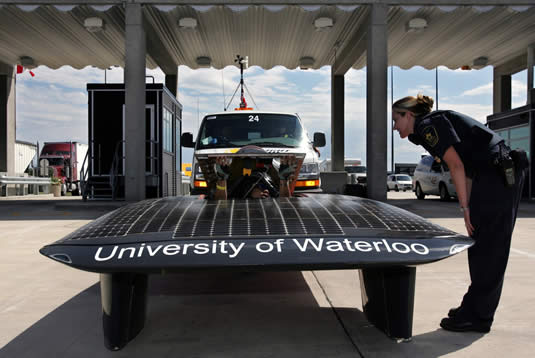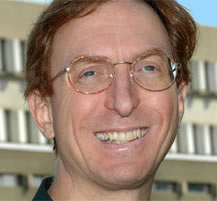- Midnight Sun team wins Landry Award
- Drummer lends his beat to IAP
- Following up
- Editor:
- Chris Redmond
- Communications and Public Affairs
- credmond@uwaterloo.ca
To reach the Daily Bulletin:
When and where
Extended library hours end on August 12: at midnight at the Davis Centre Library and at 11 p.m. at the Dana Porter Library. Hours after that are listed here.
The New Quarterly sponsors storytelling by Mary-Eileen McClear: "Forbidden Fruit and Forbidding Mushrooms" at The Quilt, 55 Downie Street, Stratford, 11:30 a.m., Saturday, August 12. Tickets $18; $15 students/seniors.
Spring term exams end August 12; unofficial marks available on Quest starting August 13.
Waterloo Regional Police are holding a bike rodeo for kids living at the Columbia Lake Village, in the CLV Community Centre parking lot, 2 pm, August 13.
'The Power of Ideas' one-day conference on accessibility, teaching technology and curriculum design, August 15, Rod Coutts Hall, details online.
Hot water shut down in all buildings inside the ring road, as well as Village I, August 23-24 (12:01 a.m. Wednesday to 4 p.m. Thursday).

UW’s Midnight Sun Solar Car Team has won the Yves Landry Foundation’s Progress Toward Sustainable Development Award (College Or University Level) for 2006. The car and team (above, seen passing customs last summer on their North American tour) won the Guinness World Record for longest journey by a solar electric vehicle. The award is one of five academic awards that will be presented at the foundation’s awards gala on October 26 at the Westin Harbour Castle in Toronto.Each award recipient will receive $5,000 “in recognition of their innovative programs to advance technological education and skills training.” It's the second year in a row that a UW student team has won this award: in 2005, the UW Alternative Fuels Team were the winners.
Drummer's beat led him to math career

“UW is fortunate that there are limited career opportunities for drummers in symphony orchestras,” says this month’s staff profile from the Keystone Campaign.
That’s the sort of statement that needs explaining, and here’s the explanation: “Otherwise, Sam Schmidt (pictured) might not have pursued a career in math and become an analyst in UW's Institutional Analysis and Planning office.”
However, the online profile goes on, “With the many connections between math and music, it's no surprise that Sam studied mathematics at UW and that he is an accomplished musician. Starting on drums 30 years ago, he has since learned to play piano and guitar.” It quotes his comments: "I play blues guitar for my daughters before their bedtime. It gives me time to practice and it's a nice way to unwind, even if I just play scales for them! With the blues, it's simple to learn the basics, but it takes a lifetime to really get it."
With three young daughters, Sam doesn't have time for much beyond work, music, and his family, although he does have a special place for 70s TV-series Columbo. "I have each of the 42 episodes on tape and have watched each one many times. My wife can tell if I've had a stressful day. I'll watch Columbo while she falls asleep. My co-workers have noticed my zest for the series. They've taken to asking me what Columbo would do in various scenarios we encounter at work!"
As usual with the monthly profiles, Schmidt answers a few questions:
What do you like best about your job at UW? “Compared to other work environments I've experienced, there is more freedom at UW and a more relaxed atmosphere. I especially like the open and connected community feel.”
What motivates you to give to UW? “I'm grateful for the education I received, and for the international recognition that UW has achieved. It feels good to support the University because I have received so much support. I designate my Keystone Campaign contribution to the Math tutor fund because I appreciate the help I received as a student.”
What do you personally value about the University? “Education and the opportunities it provides. UW is a wonderful place to learn. I visited as a high school student, did my degree here, and am now lucky to be working here.”
Do you have a favourite memory of UW? “I was in Grade 10 or 11 when a friend and I borrowed a UW student's computer account. My friend and I went to the Math building where we used punch cards to write a Fortran program. We were amazed to have that much computing power at our fingertips. Sadly, the punch cards were gone by the time I started university!”
Following up
A recent press release from UW’s media relations office amplifies an earlier announcement of UW’s and St. Jerome’s involvement in the Carnegie Academy for the Scholarship of Teaching and Learning (CASTL) institutional leadership program. UW and St. Jerome’s will each be involved in different institutional groupings within the program. “UW will be joining nine other research-intensive institutions to explore the theme of undergraduate research.... St. Jerome’s will be joining seven other institutions to explore the theme of core curriculum in liberal education.... Other Canadian institutions participating in various themes of the CASTL program are Ryerson University, Queen's University, the University of Alberta, the University of British Columbia, and the University of Victoria.”
More on the beginnings of ES1 (the Isaiah Bowman Building) from UW historian Kenneth McLaughlin: He points out that in 1962, when the geography degree program was launched, ES1 did not exist. The Isaiah Bowman Social Sciences Building was originally called Arts II and was not opened until 1967, as a plaque in the building’s lobby attests. “And, yes, I did take geography in 1962,” McLaughlin adds. “My instructor was Ralph Krueger, but geography was being taught at UW before Professor Krueger arrived from Waterloo Lutheran University.” In the building’s early days it housed the dean of arts' office until the president’s office moved from Modern Languages to Needles Hall. “And when I came here in the later 1960’s the history department was in the Bowman Building until the Humanities Building was opened.” (The Humanities Building, aka Arts III, later renamed Hagey Hall, finished construction in 1969; Needles Hall, first known as the Student Services Building, opened in 1972.)
Correction: yesterday's information on this fall's year-one student enrolment was issued by Institutional Analysis and Planning. And the highest expected difference between the target and final registration is in applied health sciences. Of course, the Faculty of Arts registers the most students.

